The poor social diversity among the higher judiciary has become a matter of concern among social activists and others who work for the scheduled castes, scheduled tribes and other backward classes. Based on the numbers given in writing in the Rajya Sabha by the Union law minister, the chairman of the National Confederation of Dalit and Adivasi Organisations pointed out that 3% of judges are SC, 2% are ST and 12 % are OBC, which makes the higher judiciary into an “exclusive club” of the upper castes. The law minister’s account also said that there are only 37 minority judges and two women judges in the Supreme Court. That defines the exclusive club even more clearly, particularly its patriarchal character. The system of selecting judges has no scope for reservations. The names are sent up by a collegium and approved by the government. The law minister said that the government has been asking the collegium to give special attention to suitable candidates from SC, ST and OBC segments, but so far the selections imply that this may not have been the case. The NACDAOR chairman and the secretary of the All India Other Backward Classes Employees Federation feel that a law or an executive order should be enacted to create the desired social diversity among the upper judiciary, since the judiciary is not taking corrective action.
It is certainly paradoxical that the institution that upholds the rights of the underprivileged and the historically oppressed should itself lack in social diversity in its higher echelons. Those wishing for change feel that without adequate representation, the points of view of the weaker-voiced segments will not be fully understood. Besides, it is only fair that the courts too should have the social diversity that has been introduced in other institutions by law. Also, courts that establish the rights of women should have more women among judges; they should exemplify the gender equality that they pronounce on. None of this is to question the wisdom or fairness of the honourable judges, but it does emphasise the importance of perception for any public institution. Public perceptions of equality, diversity and transparency are valuable in the case of the justice system. Social diversity and gender equality are issues at the forefront of public discussion; it would be reassuring if courts exhibited them.











